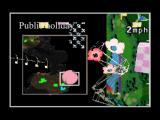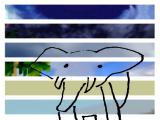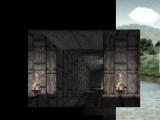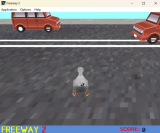This is the inline CSS I used in my Twine game, Capri Toot. Of course, I had to write some other CSS for my special horizontal hacked variant of Jonah, but this below is where almost all of the visual style of Capri Toot comes from.
----------------
#passages {
background-color: #000;
overflow:hidden;
}
----------------
"overflow: hidden" hides the horizontal scrollbar in the passages DIV, which is useful because backtracking isn't possible in Capri Toot.
----------------
@keyframes borderkeyframe
{
0% {box-shadow: 0 0 2.5em 2.5em }
50% {box-shadow: 0 0 0.5em 0.5em }
100% {box-shadow: 0 0 2.5em 2.5em }
}
@-moz-keyframes borderkeyframe
{
0% {box-shadow: 0 0 2.5em 2.5em }
50% {box-shadow: 0 0 0.5em 0.5em }
100% {box-shadow: 0 0 2.5em 2.5em }
}
@-webkit-keyframes borderkeyframe
{
0% {box-shadow: 0 0 2.5em 2.5em }
50% {box-shadow: 0 0 0.5em 0.5em }
100% {box-shadow: 0 0 2.5em 2.5em }
}
@-o-keyframes borderkeyframe
{
0% {box-shadow: 0 0 2.5em 2.5em }
50% {box-shadow: 0 0 0.5em 0.5em }
100% {box-shadow: 0 0 2.5em 2.5em }
}
----------------
CSS Keyframes: These define the animated pulsing glow behind the passages. There are four definitions because each browser has its own syntax (except IE, which doesn't support this). These define some timeline events which the browser tries to smoothly interpolate between. When the animation is 50% complete, the box-shadow is retracted to a size of 0.5em. When the animation starts and finishes, it's at its full size of 2.5em. Defining both a 0% and 100% point ensures that it loops smoothly, if an element uses it as a looping animation.
----------------
.passage:nth-child(8n+7) {
text-shadow: 0 0 0.6em hsl(0,100%,60%);
color: hsl(0,100%,50%);
background-color: hsl(0,100%,5%);
}
.passage:nth-child(8n) {
text-shadow: 0 0 0.6em hsl(45,100%,60%);
color: hsl(45,100%,50%);
background-color: hsl(45,100%,5%);
}
.passage:nth-child(8n+1) {
text-shadow: 0 0 0.6em hsl(90,100%,60%);
color: hsl(90,100%,50%);
background-color: hsl(90,100%,5%);
}
.passage:nth-child(8n+2) {
text-shadow: 0 0 0.6em hsl(135,100%,60%);
color: hsl(135,100%,50%);
background-color: hsl(135,100%,5%);
}
.passage:nth-child(8n+3) {
text-shadow: 0 0 0.6em hsl(180,100%,60%);
color: hsl(180,100%,50%);
background-color: hsl(180,100%,5%);
}
.passage:nth-child(8n+4) {
text-shadow: 0 0 0.6em hsl(225,100%,60%);
color: hsl(225,100%,50%);
background-color: hsl(225,100%,5%);
}
.passage:nth-child(8n+5) {
text-shadow: 0 0 0.6em hsl(270,100%,60%);
color: hsl(270,100%,50%);
background-color: hsl(270,100%,5%);
}
.passage:nth-child(8n+6) {
text-shadow: 0 0 0.6em hsl(315,100%,60%);
color: hsl(315,100%,50%);
background-color: hsl(315,100%,5%);
}
----------------
These are used to colour each of the zone tiers differently. When you click on a link in Jonah (as compared to Sugarcane) a new passage div is added to the end of the #passages div as a new child node. The nth-child() selector allows you to apply specific styles to an element depending on which child it is. nth-child(8n) means that every eighth child should have this style (starting with the first). nth-child(8n+1) means that every eighth child, plus 1 position over, gets this style. So, with these eight definitions, a looping cycle of eight colours is produced. This is kind of overkill for Capri Toot since you can only ever go 8 passages deep, but w/e.
Also, a note: if you don't specify a colour for box-shadow, then it falls back to using the text colour. Hence, we use a colour style here to change the animated shadow's colour without having to set up eight different keyframes (x 4 browsers).
----------------
.passage {
margin-left: 33%;
margin-right: 33%;
min-width: 33%;
margin-top: 3em;
margin-bottom: 3em;
border-radius: 8em;
border-color: white;
border-width: 2px;
box-shadow: 0 0 2.5em 2.5em;
animation: borderkeyframe 3s infinite;
-moz-animation: borderkeyframe 3s infinite;
-webkit-animation: borderkeyframe 3s infinite;
-o-animation: borderkeyframe 3s infinite;
}
----------------
The margin and min-width definitions mean that only one passage is ever visible at one time. The border-radius definition produces the delightful rounded rectangle edges. The animation definitions bind the aforementioned keyframe to this element, give it a speed (3 seconds) and tell it how many times to loop (infinite). Again, 4 definitions because each browser (except IE) has different syntax.
----------------
.passage .body .internalLink {
font-style: italic;
font-size: 1.5em;
color: white;
text-shadow: 0 0 0.6em silver;
}
.passage .body {
color: white;
text-shadow: inherit;
}
.passage .title {
margin-top: 0.2em;
font-style: italic;
font-size: 2em;
color: white;
text-align: center;
}
----------------
Fairly straightforward. Setting .body's text colour to white overrides the previous colour definition for .passage (which as I mentioned is being used for the box shadow).
----------------
.toolbar {
display:none;
}
----------------
This single-handedly hides the Jonah "rewind / bookmark" prompts for each passage. Quite convenient.






Comments
The glowing animation is
The glowing animation is super distracting.